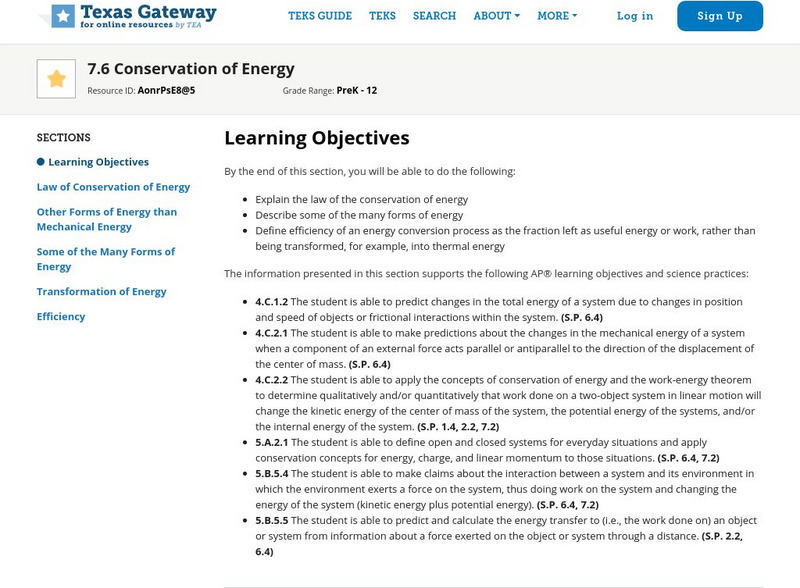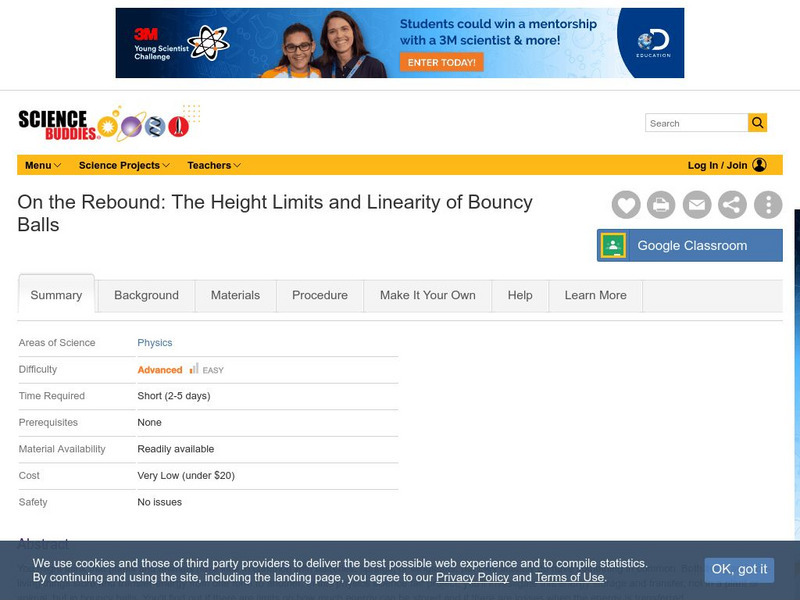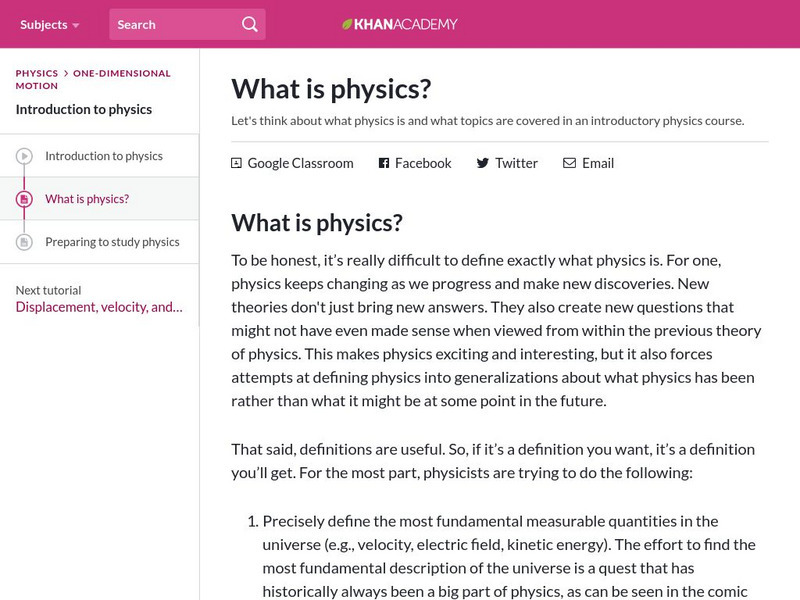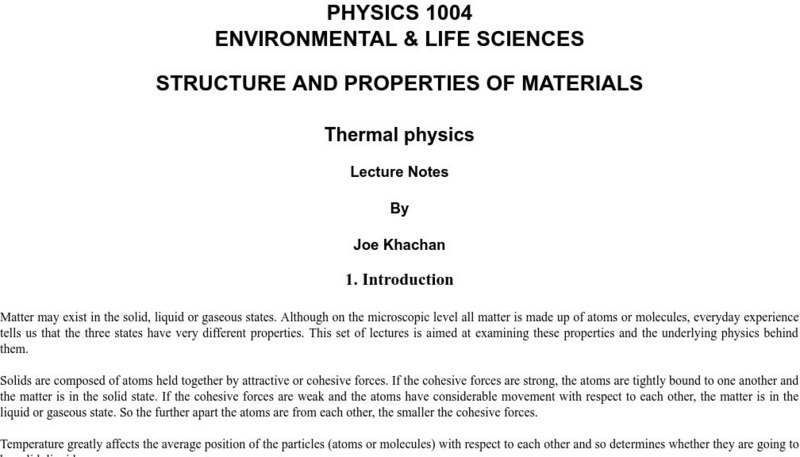Hi, what do you want to do?
Georgia State University
Georgia State University: Hyper Physics: Conservation of Energy
This site is from the Physics Department at Georgia State University. The conservation of energy as a fundamental conservation law is presented and compared to other conservation laws (momentum and angular momentum). Links to further...
Georgia State University
Georgia State University: Hyper Physics: Energy of Falling Object
This site is from the Physics Department at Georgia State University. The reliance upon the law of conservation of energy as an approach to problem-solving is presented and encouraged. It is modeled through a problem involving a...
Khan Academy
Khan Academy: What Is Thermal Energy?
Learn what thermal energy is and how to calculate it.
Texas Education Agency
Texas Gateway: Ap Physics: Conservation of Energy
By the end of this section, you will be able to explain the law of the conservation of energy; describe some of the many forms of energy; and define efficiency of an energy conversion process as the fraction left as useful energy or...
Science Buddies
Science Buddies: The Height Limits and Linearity of Bouncy Balls
You might think that plants and animals have little in common with batteries, springs, or slingshots, but they actually do have something in common. Both living and non-living things store and transfer energy from one form to another. In...
Science Struck
Science Struck: A Comprehensive List of All the Physics Formulas
Provides a long list of physics formulas for easy reference.
Nobel Media AB
The Nobel Prize: The Nobel Prize in Physics 1918: Max Planck
Use this site to learn about the scientific work of physicist, Max Planck (1858-1947 CE), whose studies in radiation and light earned him the 1918 Nobel Prize in Physics. Read his Nobel Lecture, "The genesis and present state of...
Yale University
Open Yale Courses: Fundamentals of Physics
Intended for students with a strong math and science background, a course introducing physics concepts of Newtonian mechanics, special relativity, gravitation, thermodynamics, and waves. Twenty-four class sessions in video format are...
Khan Academy
Khan Academy: What Is Physics?
Article attempts to answer the question "what is Physics?" Takes a look at concepts such as force, motion, Newton's Laws, work, energy, and much more.
Nobel Media AB
The Nobel Prize: The Nobel Prize in Physics 1961 Presentation Speech
The speech given by Prof I. Waller at the presentation of the Nobel Prize to Robert Hofstadter. Details the work both of Hofstadter and of Rudolf Mossbauer, who shared the prize. Elegantly said, with plenty of scientific detail.
Physics Classroom
The Physics Classroom: Work, Energy, and Power: Calculating Work Done by Forces
Through interactive practice problems and examples, students calculate the amount of work done by forces.
Physics Classroom
The Physics Classroom: Work, Energy, and Power: Definition/mathematics of Work
Through examples and interactive practice problems, motion will be approached from the perspective of work and energy.
Physics Classroom
The Physics Classroom: Work, Energy, and Power: Kinetic Energy
Introduce students to the concept of kinetic energy through interactive practice exercises and illustrated examples.
Physics Classroom
The Physics Classroom: Work and Energy: Which Path Requires the Most Energy?
Suppose that a car traveled up three different sloped roadways from the base of a mountain to the summit of the mountain. Which path would require the most energy? See this animation and explanation for help.
Physics Classroom
The Physics Classroom: Work and Energy: Stopping Distance of a Hot Wheels Car
Students can analyze an animation of a Hot Wheels car and use the principles of work and energy to answer the given questions.
Physics Classroom
The Physics Classroom: Work and Energy: How High Will It Go?
This animation depicts the motion of a young child sliding across the snow on a sled. Students can analyze the work and energy involved in this scenario.
Physics Classroom
The Physics Classroom: Work, Energy, and Power: Mechanical Energy
Introduce students to the concept of mechanical energy through interactive practice exercises and illustrated examples.
Physics Aviary
Physics Aviary: Work to P Ee Lab
This lab is designed to have students discover the relationship between the work that is done and the stretch of a spring. Students will get the area under a Force/Stretch graph to find the work given to a spring for a given situation....
Physics Classroom
The Physics Classroom: Work and Energy: Energy Transformation on Roller Coasters
Using a roller coaster as an example, the transformation of mechanical energy from the form of potential to the form of kinetic and vice versa is explained and illustrated in the animation.
Texas Education Agency
Texas Gateway: Work, Energy, and Power in Humans
By the end of this section, you will be able to explain the human body's consumption of energy when at rest versus when engaged in activities that do useful work and to calculate the conversion of chemical energy in food into useful work.
Khan Academy
Khan Academy: Rollercoasters Are Energy at Work!
This passage will test your knowledge on work and energy.
CK-12 Foundation
Ck 12: Physical Science: Energy
[Free Registration/Login may be required to access all resource tools.] Discusses the definition of energy, the SI unit, and the seven different forms of energy.
Read Works
Read Works: Electricity & Energy Energy
[Free Registration/Login Required] An informational text about energy. A question sheet is available to help students build skills in reading comprehension.
University of Sydney (Australia)
University of Sydney: Structure and Properties of Materials/thermal Physics
An exhaustive set of "lecture notes" on various topics in thermal physics (including thermal expansion). Explanations are well done and more interesting than most. Includes both a mathematical and conceptual treatment of topics. Humor,...



















